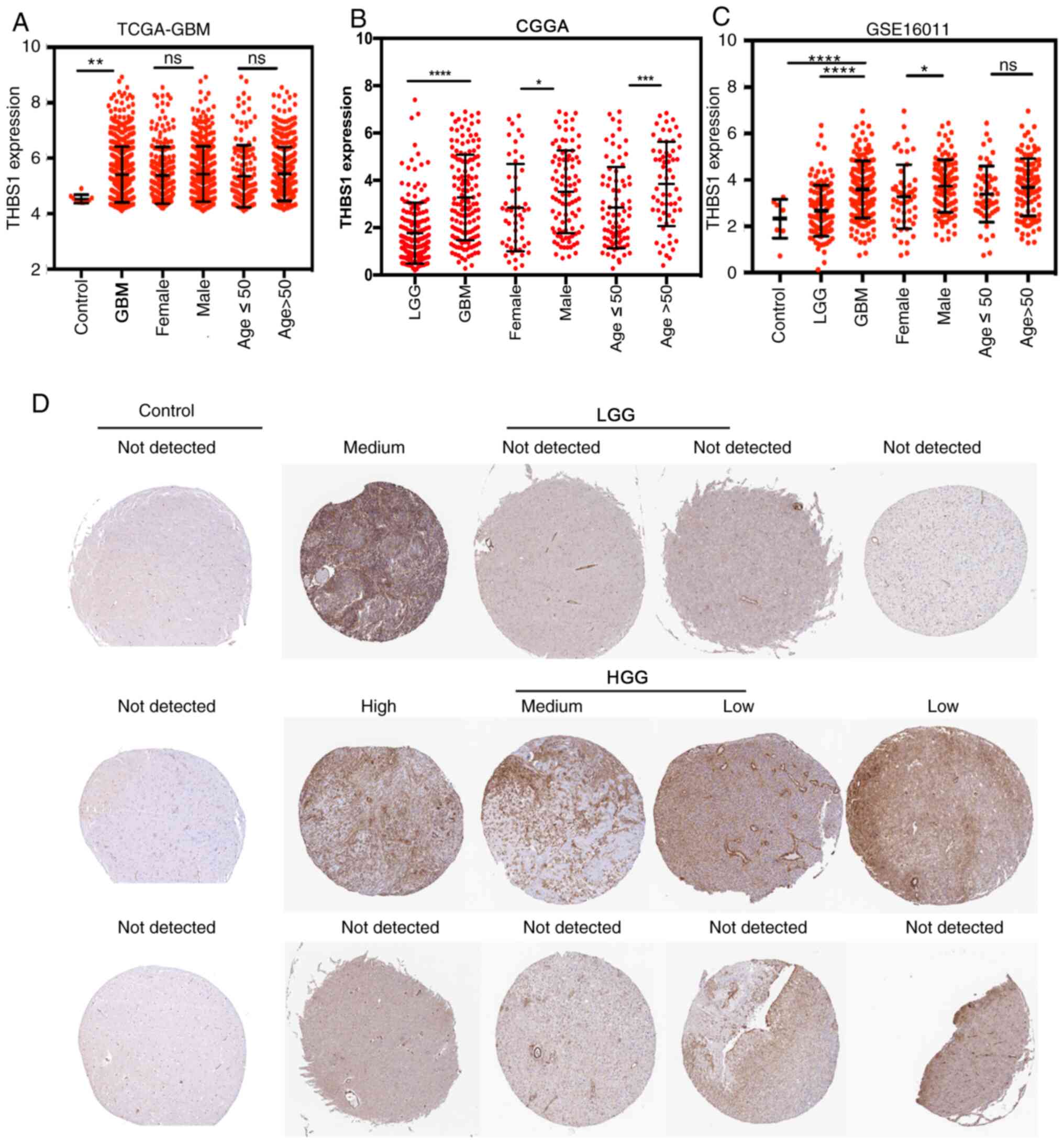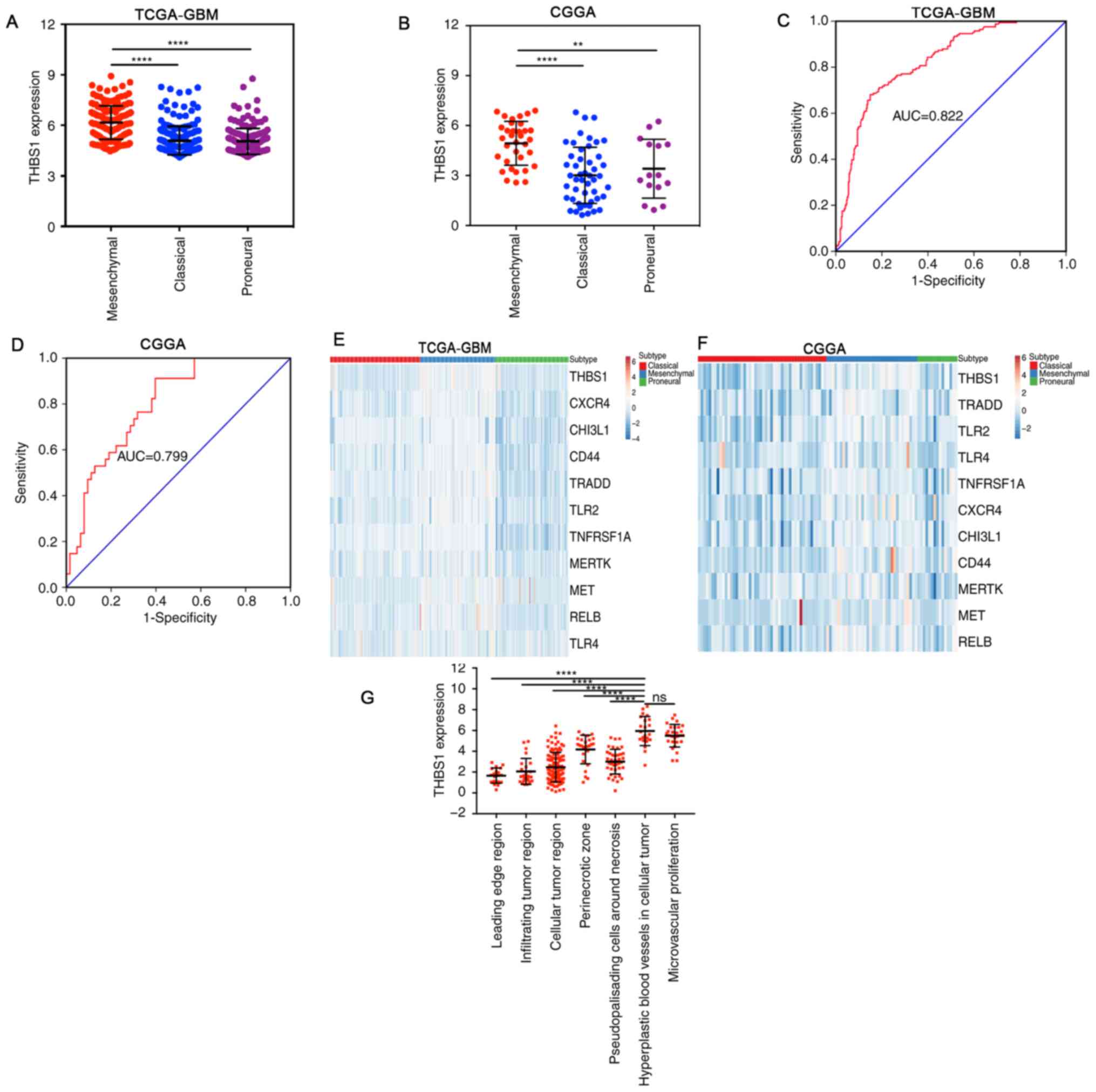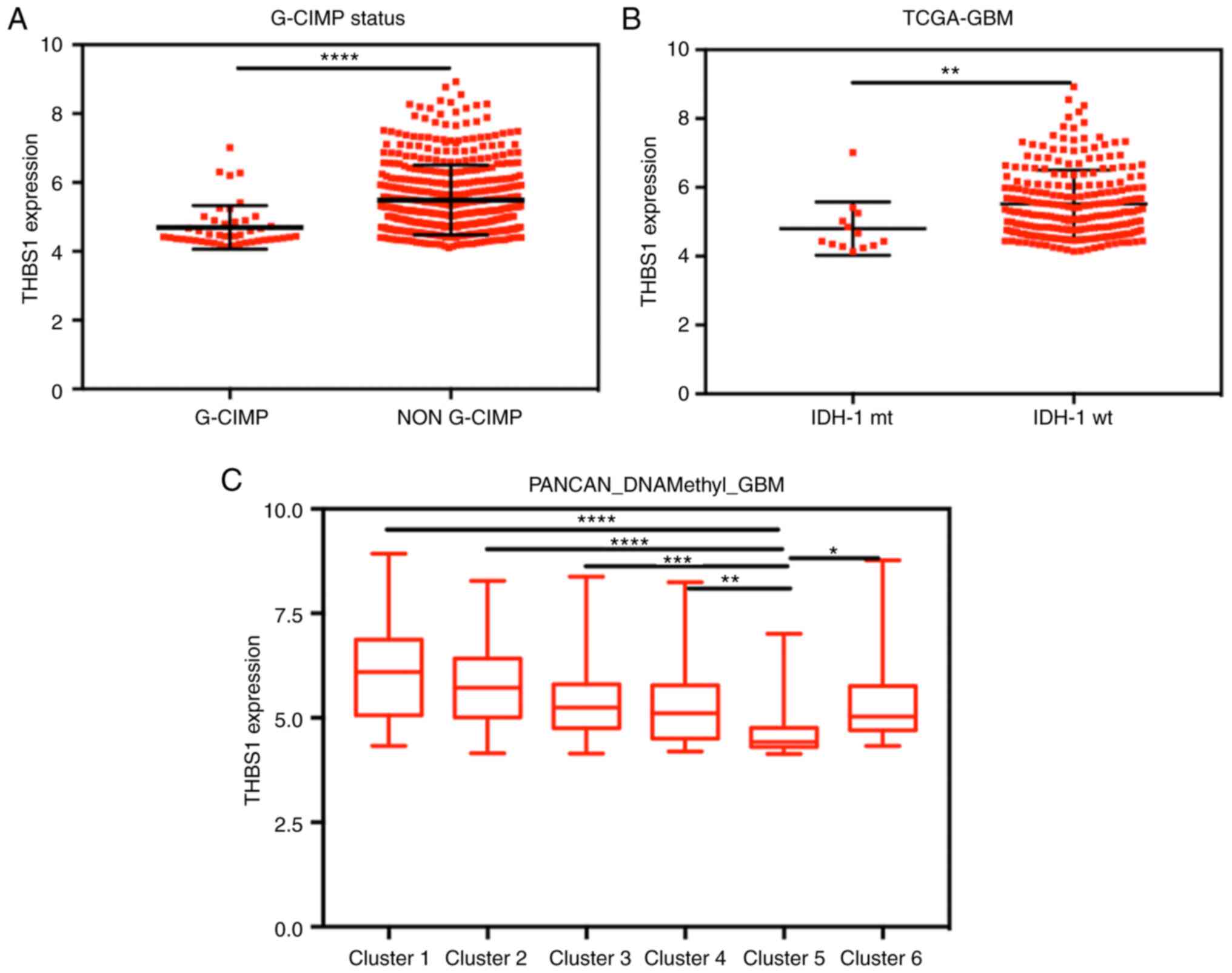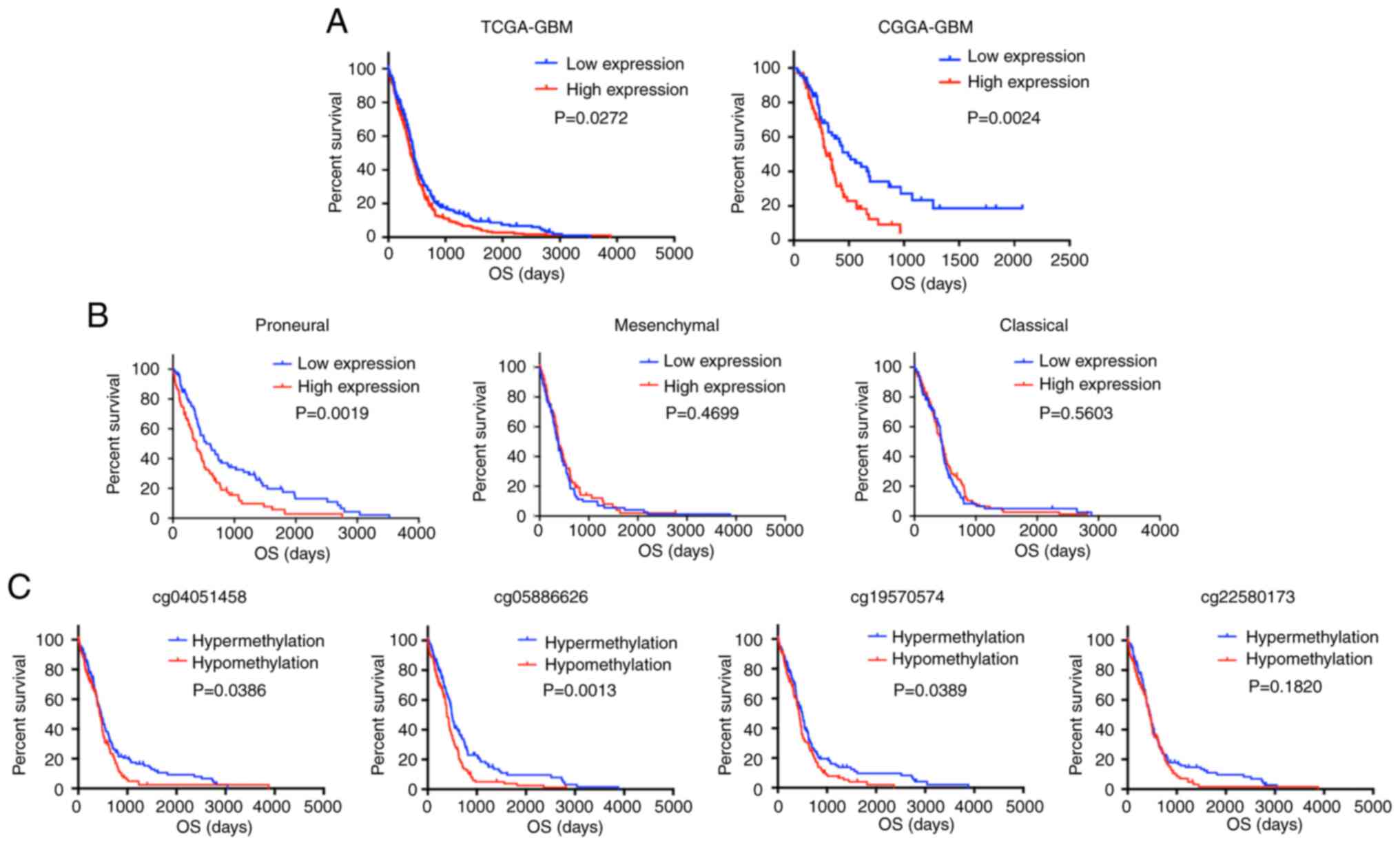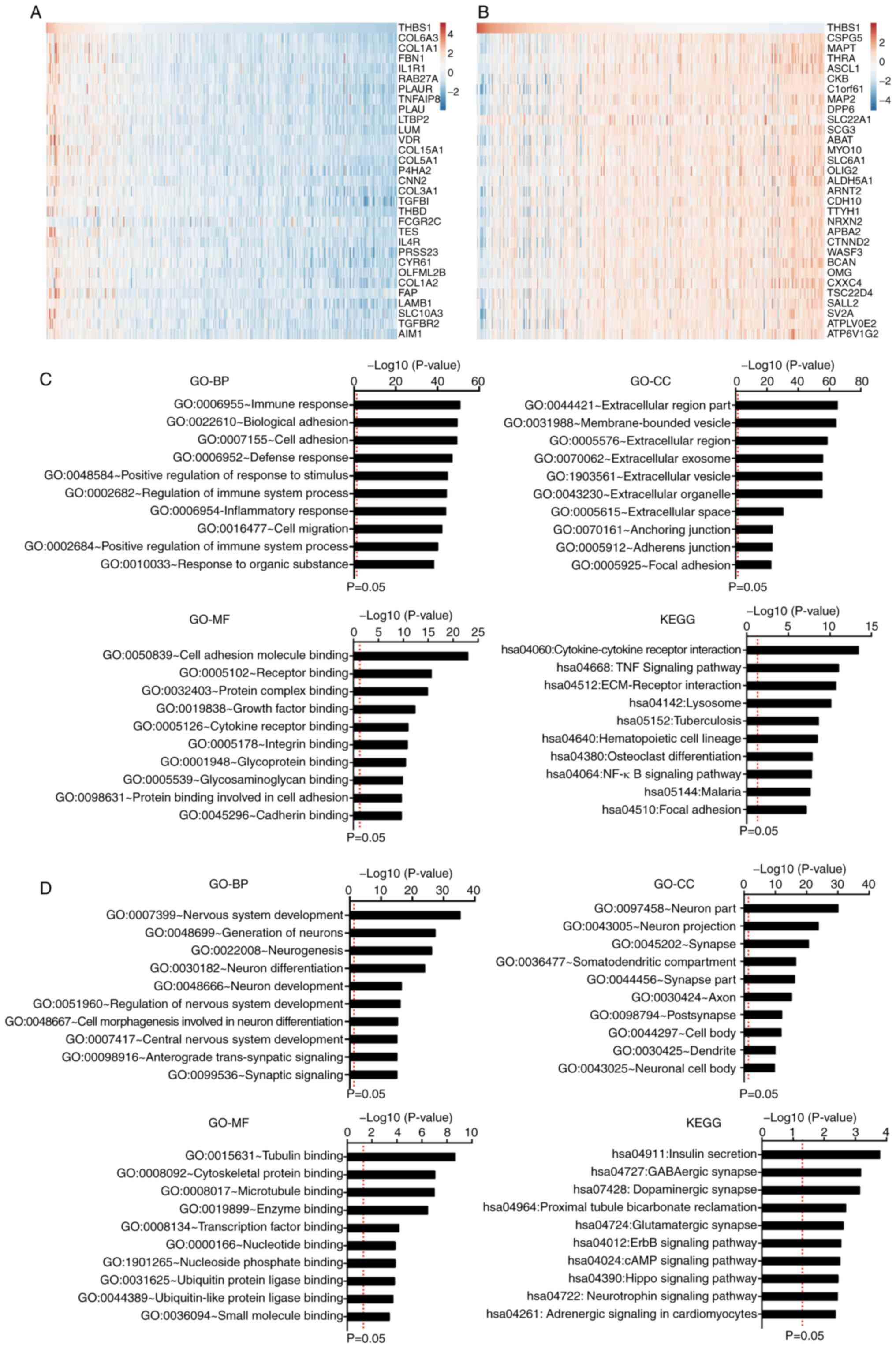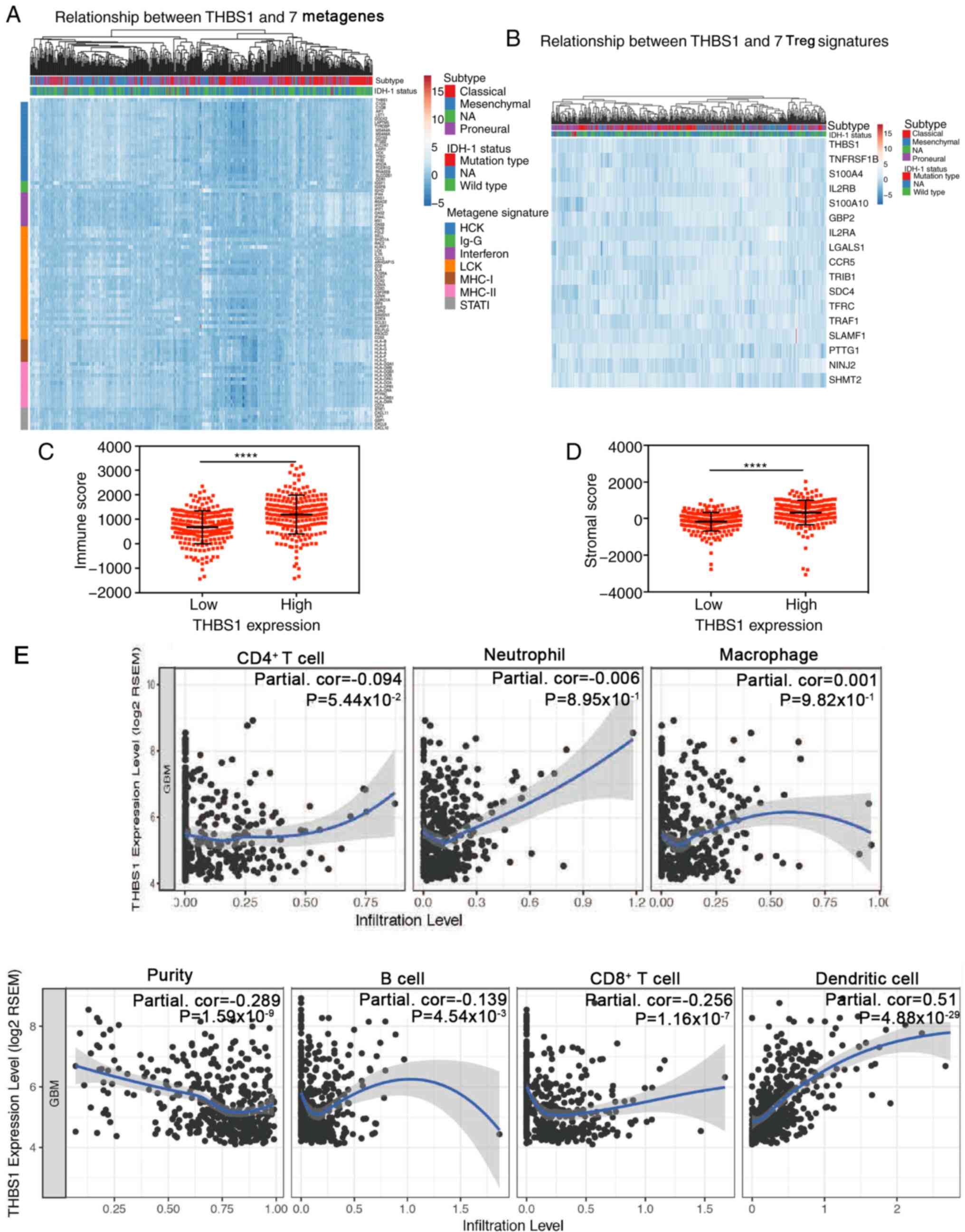|
1
|
Louis DN, Perry A, Reifenberger G, von
Deimling A, Figarella-Branger D, Cavenee WK, Ohgaki H, Wiestler OD,
Kleihues P and Ellison DW: The 2016 world health organization
classification of tumors of the central nervous system: A summary.
Acta Neuropathol. 131:803–820. 2016. View Article : Google Scholar : PubMed/NCBI
|
|
2
|
Jaoude DA, Moore JA, Moore MB,
Twumasi-Ankrah P, Ablah E and Moore DF Jr: Glioblastoma and
increased survival with longer chemotherapy duration. Kans J Med.
12:65–69. 2019. View Article : Google Scholar : PubMed/NCBI
|
|
3
|
Verhaak RG, Hoadley KA, Purdom E, Wang V,
Qi Y, Wilkerson MD, Miller CR, Ding L, Golub T, Mesirov JP, et al:
Integrated genomic analysis identifies clinically relevant subtypes
of glioblastoma characterized by abnormalities in PDGFRA, IDH1,
EGFR, and NF1. Cancer Cell. 17:98–110. 2010. View Article : Google Scholar : PubMed/NCBI
|
|
4
|
Wang Q, Hu B, Hu X, Kim H, Squatrito M,
Scarpace L, deCarvalho AC, Lyu S, Li P, Li Y, et al: Tumor
evolution of glioma-intrinsic gene expression subtypes associates
with immunological changes in the microenvironment. Cancer Cell.
32:42–56.e6. 2017. View Article : Google Scholar : PubMed/NCBI
|
|
5
|
Gill BJ, Pisapia DJ, Malone HR, Goldstein
H, Lei L, Sonabend A, Yun J, Samanamud J, Sims JS, Banu M, et al:
MRI-localized biopsies reveal subtype-specific differences in
molecular and cellular composition at the margins of glioblastoma.
Proc Natl Acad Sci USA. 111:12550–12555. 2014. View Article : Google Scholar : PubMed/NCBI
|
|
6
|
Curry JM, Sprandio J, Cognetti D,
Luginbuhl A, Bar-ad V, Pribitkin E and Tuluc M: Tumor
microenvironment in head and neck squamous cell carcinoma. Semin
Oncol. 41:217–234. 2014. View Article : Google Scholar : PubMed/NCBI
|
|
7
|
Yoshihara K, Shahmoradgoli M, Martinez E,
Vegesna R, Kim H, Torres-Garcia W, Treviño V, Shen H, Laird PW,
Levine DA, et al: Inferring tumour purity and stromal and immune
cell admixture from expression data. Nat Commun. 4:26122013.
View Article : Google Scholar : PubMed/NCBI
|
|
8
|
Hanahan D and Coussens LM: Accessories to
the crime: Functions of cells recruited to the tumor
microenvironment. Cancer Cell. 21:309–322. 2012. View Article : Google Scholar : PubMed/NCBI
|
|
9
|
Jia D, Li S, Li D, Xue H, Yang D and Liu
Y: Mining TCGA database for genes of prognostic value in
glioblastoma microenvironment. Aging (Albany NY). 10:592–605. 2018.
View Article : Google Scholar : PubMed/NCBI
|
|
10
|
Martinez-Lage M, Lynch TM, Bi Y, Cocito C,
Way GP, Pal S, Haller J, Yan RE, Ziober A, Nguyen A, et al: Immune
landscapes associated with different glioblastoma molecular
subtypes. Acta Neuropathol Commun. 7:2032019. View Article : Google Scholar : PubMed/NCBI
|
|
11
|
Miyata Y and Sakai H: Thrombospondin-1 in
urological cancer: Pathological role, clinical significance, and
therapeutic prospects. Int J Mol Sci. 14:12249–12272. 2013.
View Article : Google Scholar : PubMed/NCBI
|
|
12
|
Byrne GJ, Hayden KE, McDowell G, Lang H,
Kirwan CC, Tetlow L, Kumar S and Bundred NJ: Angiogenic
characteristics of circulating and tumoural thrombospondin-1 in
breast cancer. Int J Oncol. 31:1127–1132. 2007.PubMed/NCBI
|
|
13
|
Nakao T, Kurita N, Komatsu M, Yoshikawa K,
Iwata T, Utsunomiya T and Shimada M: Expression of thrombospondin-1
and Ski are prognostic factors in advanced gastric cancer. Int J
Clin Oncol. 16:145–152. 2011. View Article : Google Scholar : PubMed/NCBI
|
|
14
|
Trotter MJ, Colwell R and Tron VA:
Thrombospondin-1 and cutaneous melanoma. J Cutan Med Surg.
7:136–141. 2003. View Article : Google Scholar : PubMed/NCBI
|
|
15
|
Wu MP, Tzeng CC, Wu LW, Huang KF and Chou
CY: Thrombospondin-1 acts as a fence to inhibit angiogenesis that
occurs during cervical carcinogenesis. Cancer J. 10:27–32. 2004.
View Article : Google Scholar : PubMed/NCBI
|
|
16
|
Zhang J, Yang W, Zhao D, Han Y, Liu B,
Zhao H, Wang H, Zhang Q and Xu G: Correlation between TSP-1, TGF-β
and PPAR-γ expression levels and glioma microvascular density.
Oncol Lett. 7:95–100. 2014. View Article : Google Scholar : PubMed/NCBI
|
|
17
|
Tenan M, Fulci G, Albertoni M, Diserens
AC, Hamou MF, El Atifi-Borel M, Feige JJ, Pepper MS and Van Meir
EG: Thrombospondin-1 is downregulated by anoxia and suppresses
tumorigenicity of human glioblastoma cells. J Exp Med.
191:1789–1798. 2000. View Article : Google Scholar : PubMed/NCBI
|
|
18
|
Kragh M, Quistorff B, Tenan M, Van Meir EG
and Kristjansen PE: Overexpression of thrombospondin-1 reduces
growth and vascular index but not perfusion in glioblastoma. Cancer
Res. 62:1191–1195. 2002.PubMed/NCBI
|
|
19
|
Zhang HP, Wu Y, Liu J, Jiang J, Geng XR,
Yang G, Mo L, Liu ZQ, Liu ZG and Yang PC: TSP1-producing B cells
show immune regulatory property and suppress allergy-related
mucosal inflammation. Sci Rep. 3:33452013. View Article : Google Scholar : PubMed/NCBI
|
|
20
|
de Fraipont F, Keramidas M, El Atifi M,
Chambaz EM, Berger F and Feige JJ: Expression of the thrombospondin
1 fragment 167–569 in C6 glioma cells stimulates tumorigenicity
despite reduced neovascularization. Oncogene. 23:3642–3649. 2004.
View Article : Google Scholar : PubMed/NCBI
|
|
21
|
Daubon T, Léon C, Clarke K, Andrique L,
Salabert L, Darbo E, Pineau R, Guérit S, Maitre M, Dedieu S, et al:
Deciphering the complex role of thrombospondin-1 in glioblastoma
development. Nat Commun. 10:11462019. View Article : Google Scholar : PubMed/NCBI
|
|
22
|
Ma Y, Qu B, Xia X, Yang L, Kuang Y, Yang
T, Cheng J, Sun H, Fan K and Gu J: Glioma-derived thrombospondin-1
modulates cd14+ cell tolerogenic properties. Cancer Invest.
33:152–157. 2015. View Article : Google Scholar : PubMed/NCBI
|
|
23
|
Cancer Genome Atlas Research Network, .
Comprehensive genomic characterization defines human glioblastoma
genes and core pathways. Nature. 455:1061–1068. 2008. View Article : Google Scholar : PubMed/NCBI
|
|
24
|
Uhlen M, Oksvold P, Fagerberg L, Lundberg
E, Jonasson K, Forsberg M, Zwahlen M, Kampf C, Wester K, Hober S,
et al: Towards a knowledge-based Human Protein Atlas. Nat
Biotechnol. 28:1248–1250. 2010. View Article : Google Scholar : PubMed/NCBI
|
|
25
|
Bowman RL, Wang Q, Carro A, Verhaak RG and
Squatrito M: GlioVis data portal for visualization and analysis of
brain tumor expression datasets. Neuro Oncol. 19:139–141. 2017.
View Article : Google Scholar : PubMed/NCBI
|
|
26
|
Rody A, Holtrich U, Pusztai L, Liedtke C,
Gaetje R, Ruckhaeberle E, Solbach C, Hanker L, Ahr A, Metzler D, et
al: T-cell metagene predicts a favorable prognosis in estrogen
receptor-negative and HER2-positive breast cancers. Breast Cancer
Res. 11:R152009. View Article : Google Scholar : PubMed/NCBI
|
|
27
|
Wang ZL, Li GZ, Wang QW, Bao ZS, Wang Z,
Zhang CB and Jiang T: PD-L2 expression is correlated with the
molecular and clinical features of glioma, and acts as an
unfavorable prognostic factor. Oncoimmunology. 8:e15415352019.
View Article : Google Scholar : PubMed/NCBI
|
|
28
|
Zhou Y, Wang X, Huang X, Li XD, Cheng K,
Yu H, Zhou YJ, Lv P and Jiang XB: High expression of COPB2 predicts
adverse outcomes: A potential therapeutic target for glioma. CNS
Neurosci Ther. 26:309–318. 2019. View Article : Google Scholar : PubMed/NCBI
|
|
29
|
Li T, Fan J, Wang B, Traugh N, Chen Q, Liu
JS, Li B and Liu XS: TIMER: A web server for comprehensive analysis
of tumor-infiltrating immune cells. Cancer Res. 77:e108–e110. 2017.
View Article : Google Scholar : PubMed/NCBI
|
|
30
|
Yi L, Tong L, Li T, Hai L, Abeysekera IR,
Tao Z, Ma H, Liu P, Xie Y, Li J, et al: Bioinformatic analyses
reveal the key pathways and genes in the CXCR4 mediated mesenchymal
subtype of glioblastoma. Mol Med Rep. 18:741–748. 2018.PubMed/NCBI
|
|
31
|
Turcan S, Rohle D, Goenka A, Walsh LA,
Fang F, Yilmaz E, Campos C, Fabius AWM, Lu C, Ward PS, et al: IDH1
mutation is sufficient to establish the glioma hypermethylator
phenotype. Nature. 483:479–483. 2012. View Article : Google Scholar : PubMed/NCBI
|
|
32
|
Balss J, Meyer J, Mueller W, Korshunov A,
Hartmann C and von Deimling A: Analysis of the IDH1 codon 132
mutation in brain tumors. Acta Neuropathol. 116:597–602. 2008.
View Article : Google Scholar : PubMed/NCBI
|
|
33
|
Razavi SM, Lee KE, Jin BE, Aujla PS,
Gholamin S and Li G: Immune evasion strategies of glioblastoma.
Front Surg. 3:112016. View Article : Google Scholar : PubMed/NCBI
|
|
34
|
Pan JH, Zhou H, Cooper L, Huang JL, Zhu
SB, Zhao XX, Ding H, Pan YL and Rong L: LAYN is a prognostic
biomarker and correlated with immune infiltrates in gastric and
colon cancers. Front Immunol. 10:62019. View Article : Google Scholar : PubMed/NCBI
|
|
35
|
Zhang C, Cheng W, Ren X, Wang Z, Liu X, Li
G, Han S, Jiang T and Wu A: Tumor purity as an underlying key
factor in glioma. Clin Cancer Res. 23:6279–6291. 2017. View Article : Google Scholar : PubMed/NCBI
|
|
36
|
Wu LM, Zhang F, Zhou L, Yang Z, Xie HY and
Zheng SS: Predictive value of CpG island methylator phenotype for
tumor recurrence in hepatitis B virus-associated hepatocellular
carcinoma following liver transplantation. BMC Cancer. 10:3992010.
View Article : Google Scholar : PubMed/NCBI
|
|
37
|
Strathdee G, Appleton K, Illand M, Millan
DW, Sargent J, Paul J and Brown R: Primary ovarian carcinomas
display multiple methylator phenotypes involving known tumor
suppressor genes. Am J Pathol. 158:1121–1127. 2001. View Article : Google Scholar : PubMed/NCBI
|
|
38
|
Doucette T, Rao G, Rao A, Shen L, Aldape
K, Wei J, Dziurzynski K, Gilbert M and Heimberger AB: Immune
heterogeneity of glioblastoma subtypes: Extrapolation from the
cancer genome atlas. Cancer Immunol Res. 1:112–122. 2013.
View Article : Google Scholar : PubMed/NCBI
|















